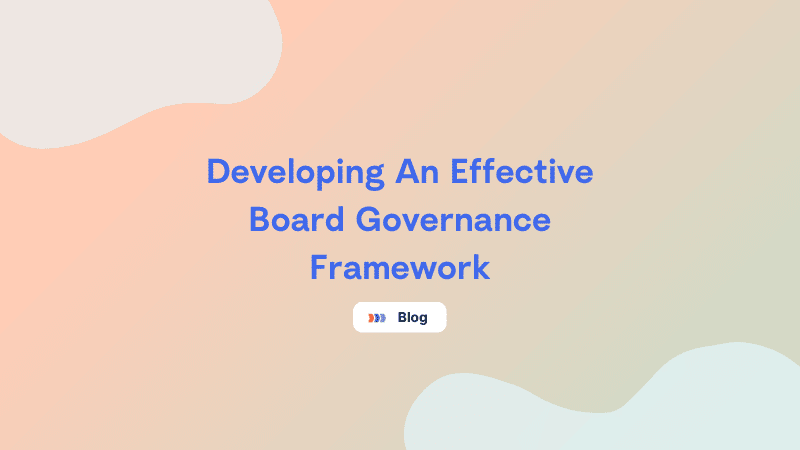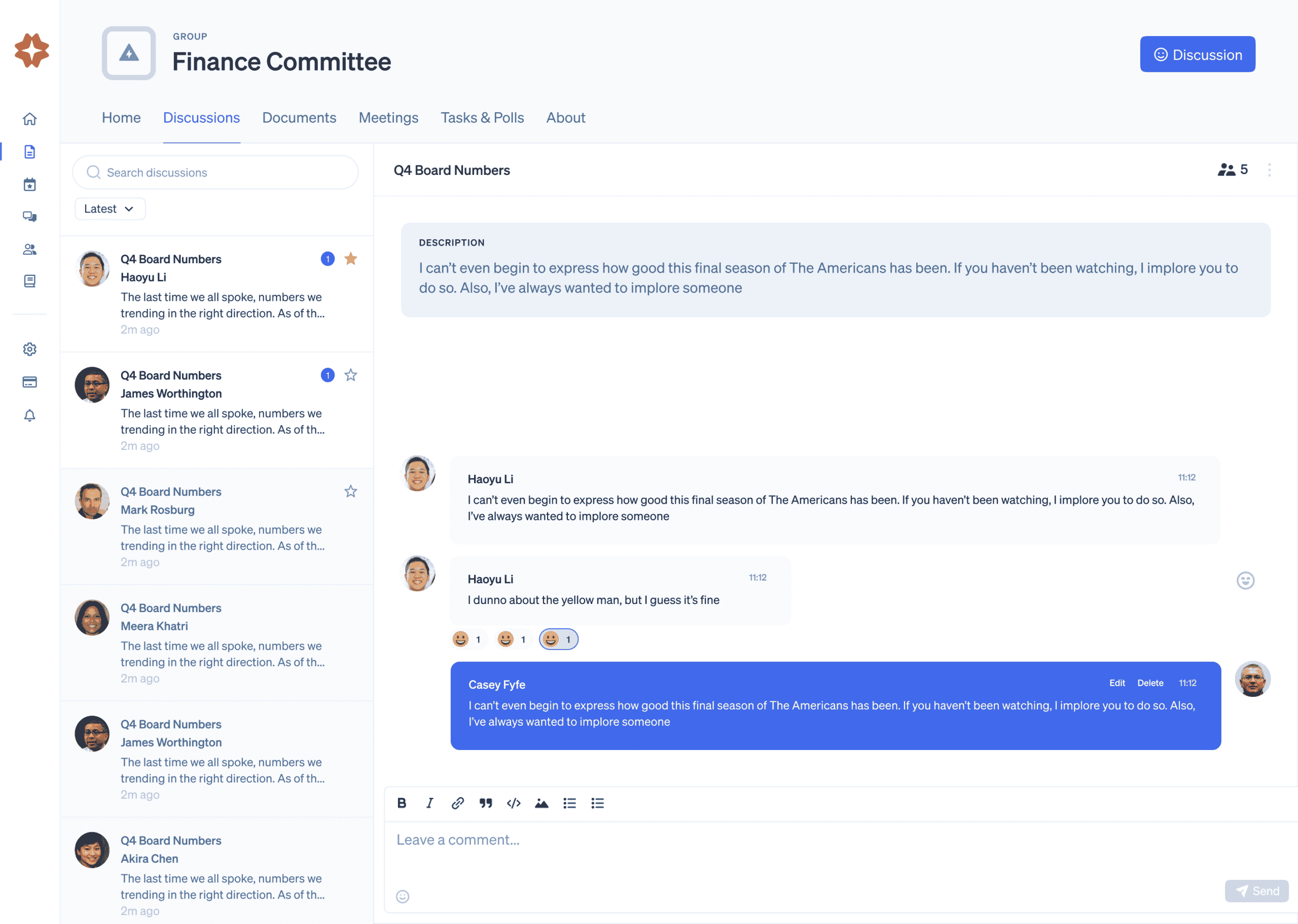The governing body of an organization or company is tasked with overseeing the management and setting a strategy for the organization. Board members are elected or appointed typically by shareholders or anyone with some vested interest in the company’s success. Developing an effective board governance framework is critical to the success of the organization.
Essentially, a board is a panel of people who are expected and often legally required to carry out an organization’s governance without regard for personal gain. Establishing a solid board governance framework gives board members, senior management, and operational level company representatives a clear understanding of expectations, performance criteria, objectives, and reporting requirements.
Corporate governance principles encompass accountability, transparency, fairness, and responsibility. Environmental awareness, ethical behavior, corporate strategy, and risk management are part of a board governance framework. Within board governance falls an area of operations, the active process of operating or managing an organization. Therefore, the operational governance framework is focused on the decisions made by company executives and managers. The operational governance framework offers a framework for management personnel to continually improve decision-making processes and how decisions are carried out.
A board governance framework diagram is a flowchart showing the structure of the governance model framework. A visual representation of each part of an organization or company and where they fall in the governance model. A governance framework diagram will show relationships and visually display how interconnected departments and employees influence the organization. Another essential element includes risk management and security risks. The corporate governance framework establishes policies, sets objectives, establishes values, creates culture, and sets accountabilities and performance objectives. Within the framework and operational governance framework, these objectives can be achieved through actionable management practices.
Corporate Governance Framework Template
A corporation or institution needs a framework by which to operate. Without one, the company’s leaders may veer in different directions and never find a way to move forward cohesively. The beauty of a governance framework is that it allows leaders with different strengths and ideas to come together to make decisions and form a plan of action that includes their diversity while guiding them to stay within a framework of rules, policies, and processes.
What does a board governance framework look like? It is the system of rules, policies, and processes with underlying principles including accountability, transparency, openness, integrity, stewardship, efficiency, and leadership. All of these fall within the framework of corporate governance.
A corporate governance framework template is pre-set guidelines that help organizations establish their corporate governance framework. Often available in different formats, a corporate governance framework template word doc may have flow charts to fill in and bullet-pointed lists helping an organization define rules, policies, and processes that align with their corporate governance framework.
In addition, once a corporate governance framework is established, a company now has its own corporate governance framework template to use as a starting point for subsidiaries. The subsidiary governance framework template is an extension of a corporate governance framework template. For example, a parent company may have a headquarters overseeing many aspects and locations within the same organization. A subsidiary governance framework template is developed for different areas of responsibility within a large corporation to ensure the company remains within the established corporate governance framework.
Board Governance Framework Template
To survive in the global marketplace, the importance of corporate governance is growing. Trust is built with integrity and efficiency. Consistently operating within a well-established corporate board governance framework template reinforces integrity and efficiency that employees, shareholders, and customers can experience from within and without an organization. Shareholders’ trust in a company is valuable, and a well-developed governance framework template will help renew shareholders’ confidence. Shareholders may access a company’s governance framework template to understand the rules, processes, and policies in place and ensure they get a fair return on their investment.
There are many levels of governance needed within corporate governance. For example, the amount of data required to operate in today’s global market is extensive. How to handle that data is now an issue to be addressed as part of a corporate governance framework. Therefore, a data governance framework template is necessary to ensure consistency in adhering to the company’s rules, policies, and processes. In addition, a company has many projects and project team members to carry out those assignments. A project governance framework template will help teams maintain integrity and consistency as they carry out their work on a project.
What Are The Elements Of A Governance Framework
First, what exactly is the board governance framework? It is a set of policies, procedures, and processes by which a company is governed. A governance operating model includes these four major components: structure, oversight responsibilities, talent and culture, and infrastructure. What is the difference between a governance framework and a governance model? Board governance framework examples include a guidance system of rules, policies, and processes to guide actionable decisions to stay within the framework; however, a governance framework does not necessarily decide the actionable decisions. Whereas a governance operating model helps define actionable steps, the work, and authority of those involved. Governance frameworks and standards ensure that the actions and decisions made by those operating within the governance operating model stay consistent with the integrity of the policies and procedures established by the governance framework.
Two well-known governance framework examples include the Anglo-US model and the German model. The Anglo-US model is focused on the stock market, and the German model is focused on banking and credit markets. The US-Anglo model is shareholder-oriented, and there is a clear separation between ownership and management. With the German model, also referred to as the European model, workers are critical stakeholders in a company and can participate in how a company is managed. One main difference is that in the US-Anglo governance operating model, shareholders may or may not have any other role in the company, and often workers are not shareholders. Whereas in the German governance operating model, workers are key stakeholders.
Types of Governance Structure
Types of governance structure include three primary structures: internal and external mechanisms and independent audits. Reporting lines and performance measures are included in internal mechanisms. Internal mechanisms monitor the activities and progress of an organization. Then take steps to make corrections when necessary. For example, a corporation’s governance operating model typically employs a combination of these various mechanisms. The internal mechanism in the governance structure serves internal objectives and internal stakeholders such as employees, management personnel, and owners. The external mechanisms included in the types of governance structure are influenced by entities outside the organization, such as governments, trade unions, and financial institutions. The goal of the external mechanism is debt management and legal compliance.
A governance operating model takes the elements of the governance framework and converts them into actionable practices, procedures, and job responsibilities. A governance operating model applies the governance framework within the corporate governance infrastructure. There are four types of governance operating models: advisory, cooperative, management team, and policy board. Corporate governance and a governance operating model go hand in hand. A governance operating model identifies the structure and interactions used to put governance into action. The Board of directors and subcommittees can use a governance operating model as an essential tool to enhance oversight capabilities while empowering management to implement initiatives at each level of the corporation.
Governance Standards
A governance framework offers guidance through a system of standard management practices designed to fit the organization. A governance framework sets objectives, culture, policies, values, accountabilities, and performance expectations. Establishing governance frameworks and standards is critical for modern corporate governance. The governance framework provides parameters for how people interact with the organization as a whole, with stakeholders and regulators. The governance framework provides a consistent set of guidelines helping the organization center its approach around common themes. In addition, governance frameworks and standards help a company establish authority and trust in an industry by ensuring consistency, transparency, and accountability within and without the organization.
Governance structures fall into two basic categories: policy boards and administrative boards. The policy board or management team board governance structure is typically used in the non-profit sector. A policy governance board is a more formal governance structure where the board operates as a whole. The working board governance structure operates with directors having a more hands-on role with administrative functions. The collective board governance structure operates as a collective board. Governance structure pdf templates will show the role of committees within an organization as the type of governance structure employed is related to the number and type of committees established.
Good Governance Structure & Outline
Developing a good governance framework starts with establishing a strategy and vision. A governance framework is a conceptual structure, a set of rules outlining how a company or organization is managed. While these are conceptual frameworks, they are established using governance models and governance framework templates. They are conceptual frameworks outlined with tangible documents.
Good governance in the public sector helps companies move forward confidently, helping enterprises deliver clear outcomes with accountability and transparency regarding how results are achieved. Companies that conduct public sector business also often need an international framework: good governance in the public sector.
Our digital platform allows you to develop good governance frameworks and engage your board members. In the past, board governance included in-person meetings, discussions, and a voting process. Now, along with almost every other area of business, board governance can move online. With Boardable you can move your board governance tasks to a digital platform, streamlining reports, sharing secure documents and meeting minutes, and allowing board members to sign documents using a safe and verified e-signature.




